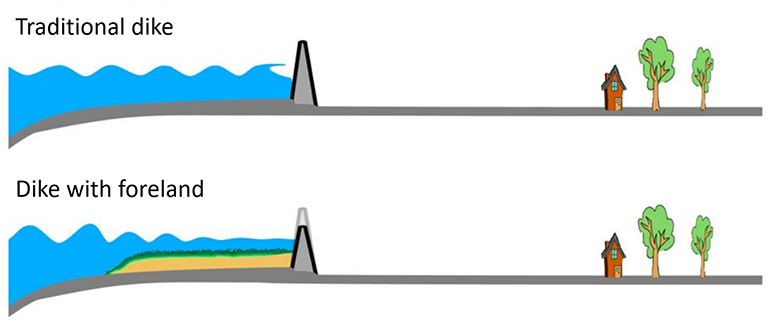Coastal forelands
Coastal forelands are unprotected areas between the sea or estuary and a dike, and are common features in the Rhine-Meuse delta. Most forelands consist of a high-lying salt marsh alongside a dike with lower unvegetated mud flats lying in front. In the Water, Climate and Future Deltas hub, research on forelands focusses on their potential contribution to flood defence and the related legal considerations.

Functioning of forelands
Many open questions
Tjeerd Bouma, professor of bio-geomorphological ecology of estuaries, explores the application of coastal forelands as a cost-effective and nature-based method of flood defence. He explains: "We are exploring various aspects of the functioning of forelands, from their mechanism to attenuate waves and reduce the number of dike failures, to their capacity to grow with the rising sea level."
Historic proof
Using historic data from flood disasters in Northwest Europe, Zhenchang Zhu, Tjeerd Bouma and other colleagues showed that forelands can reduce both the chance and impact of a dike breach. In addition, they found that forelands reduced the magnitude of the floods by limiting the size of the breach when the dike has failed.
Climate resilience
Forelands are self-adapting systems that can buffer the effect of sea-level rise by accumulating sediment. The exact capacity of forelands to adapt to sea-level rise is still unknown and research on climate resilience of coastal systems has only just started. Tjeerd Bouma therefore suggests, "Future research must focus on designing tools to monitor and predict the capacity of forelands and other coastal systems to adapt to a changing climate". An example of such a tool is the TiDyWAVE flume which has been developed by Jaco de Smit, Maarten Kleinhans, Tjeerd Bouma and other colleagues. By using the flume for in situ measurements to identify location specific hydrodynamic thresholds for future seagrass meadow stability, they found that increasing mean wind velocity has a stronger influence on the stability than increasing storminess.

Legal instruments
Developments in forelands
As forelands must be included in the periodic assessments of primary flood defences, it is important that water management authorities have and maintain proper insight into the physical circumstances and planned or expected developments in these areas. For that purpose, they should have effective (legal) instruments to conduct the necessary research and to steer or even prohibit potentially negative developments, particularly where forelands are privately owned or intensively used.
Water management authorities can largely determine their own policies regarding forelands on the basis of local circumstances
The Dutch system of water law provides such instruments. Herman Kasper Gilissen, associate professor of environmental and water law and governance, elaborates, “Water management authorities can largely determine their own policies regarding forelands on the basis of local circumstances; they can determine themselves whether they want to take a strict conservative stance or leave room for development in forelands. They have to keep in mind, though, that developments in forelands could affect the system’s overall water-retaining capacity, which in turn could necessitate dike reinforcements”.

